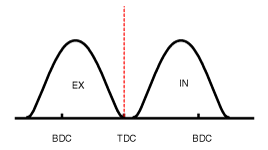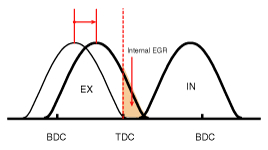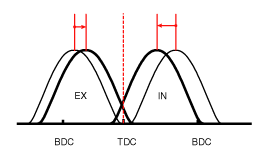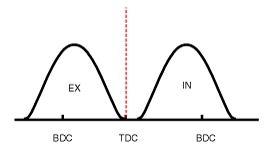 Kia Sportage: CVVT (Continuously Variable Valve Timing) System: Description and Operation
Kia Sportage: CVVT (Continuously Variable Valve Timing) System: Description and Operation
Third generation SL (2010ŌĆō2016) / Kia Sportage SL Service & Repair Manual / Emission Control System / Exhaust Emission Control System / CVVT (Continuously Variable Valve Timing) System: Description and Operation
| Description |
Continuous Variable Valve Timing (CVVT) system advances or
retards the valve timing of the intake and exhaust valve in accordance
with the ECM control signal which is calculated by the engine speed and
load.
By controlling CVVT, the valve over-lap or under-lap occurs,
which makes better fuel economy and reduces exhaust gases (NOx, HC) and
improves engine performance through reduction of pumping loss, internal
EGR effect, improvement of combustion stability, improvement of
volumetric efficiency, and increase of expansion work.
This system consist of
| ŌĆō |
the CVVT Oil Control Valve (OCV) which supplies the engine
oil to the cam phaser or runs out the engine oil from the cam phaser in
accordance with the ECM PWM (Pulse With Modulation) control signal, |
| ŌĆō |
and the Cam Phaser which varies the cam phase by using the hydraulic force of the engine oil. |
The engine oil getting out of the CVVT oil control valve
varies the cam phase in the direction (Intake Advance/Exhaust Retard) or
opposite direction (Intake Retard/Exhaust Advance) of the engine
rotation by rotating the rotor connected with the camshaft inside the
cam phaser.
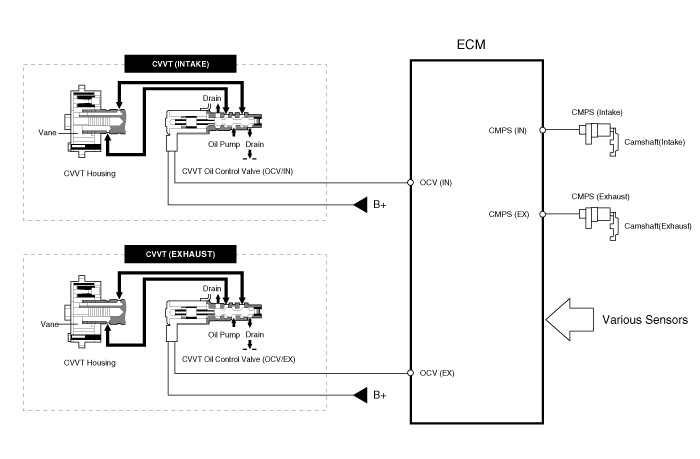
| Operation Principle |
The CVVT has the mechanism rotating the rotor vane with
hydraulic force generated by the engine oil supplied to the advance or
retard chamber in accordance with the CVVT oil control valve control.
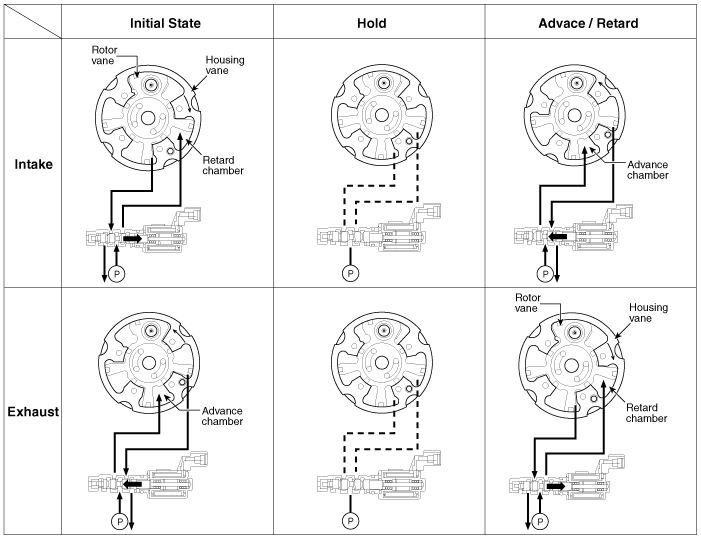
| [CVVT System Mode] |
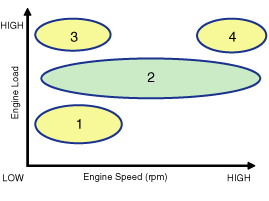
| (1) Low Speed / Low Load | (2) Part Load |
|
|
| (3) Low Speed / High Load | (4) High Speed / High Load |
|
|
| Driving Condition | Exhaust Valve | Intake Valve | ||
| Valve Timing | Effect | Valve Timing | Effect | |
| (1) Low Speed /Low Load | Completely Advance | * Valve Under-lap * Improvement of combustion stability | Completely Retard | * Valve Under-lap * Improvement of combustion stability |
| (2) Part Load | Retard | * Increase of expansion work * Reduction of pumping loss * Reduction of HC | Retard | * Reduction of pumping loss |
| (3) Low Speed /High Load | Retard | * Increase of expansion work | Advance | * Prevention of intake back flow (Improvement of volumetric efficiency) |
| (4) High Speed /High Load | Advance | * Reduction of pumping loss | Retard | * Improvement of volumetric efficiency |
 Catalytic Converter: Description and Operation
Catalytic Converter: Description and Operation
Description
The catalytic converter of the gasoline engine is a three way
catalyst. It oxidizes carbon monoxide and hydrocarbons (HC), and
separates oxygen from the oxides of nitrogen (NOx).
T ...
Other Information:
Seat Belt Buckle Switch (BS): Description and Operation
Description
The SRSCM shall monitor the status of the driver and front
passenger seat belt buckle. The SRSCM provides one pin each for the
driver and front passenger seat belt buckle status inp ...
Temperature control
The temperature will increase to the maximum (HI) by turning the knob to the
extreme right.
The temperature will decrease to the minimum (Lo) by turning the knob to the
extreme left.
When turn ...
Categories
- Home
- Kia Sportage QL (2015-2019) Owners Manual
- Kia Sportage QL (2015-2019) Service Manual
- Kia Sportage SL 2010-2016 Owners Manual
- Kia Sportage SL 2010-2016 Service Manual
Copyright ® www.kispmanual.com 2014-2025

